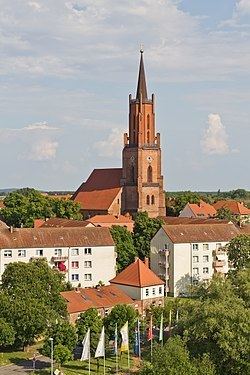Time zone CET/CEST (UTC+1/+2) Local time Saturday 3:58 AM | Elevation 29 m (95 ft) Postal codes 14702, 14712 Population 25,791 (31 Dec 2008) | |
 | ||
Weather 0°C, Wind W at 5 km/h, 87% Humidity Points of interest Optikpark, Kulturzentrum Rathenow GmbH, Optik‑Industrie‑Museum‑Rathenow (OIMR), Edwin‑Rolf‑Platz, Kurfürstendenkmal | ||
Rathenow ( [ˈʁaːtənoː]) is a town in the district of Havelland in Brandenburg, Germany, with a population of 26,433 (2007).
Contents
Map of Rathenow, Germany
Overview
The Protestant church of St. Marien Andreas, originally a basilica, and transformed to the Gothic style in 1517-1589, and the Roman Catholic Church of St. George, are noteworthy.
Rathenow is known for its Rathenow stones, bricks made of the clay of the Havel, and for its spectacles and optical instruments, which are exported.
After the fall of the Soviet Union, it was revealed that the remains of Hitler and his assistants were secretly buried in graves near Rathenow.
Twin towns — sister cities
Rathenow is twinned with:
Notable residents
References
Rathenow Wikipedia(Text) CC BY-SA
